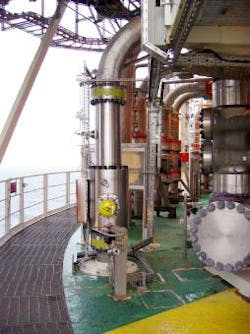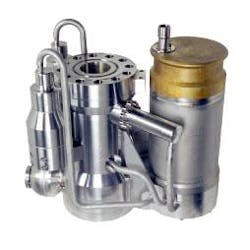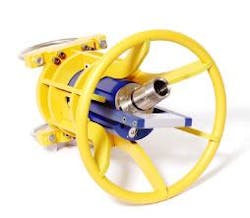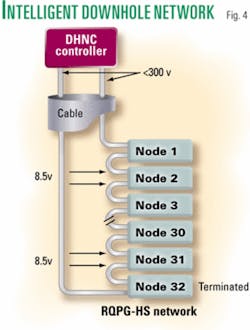Moving multiphase metering technology and other sensors downhole, incorporating sand detection technology, and developing an intelligent downhole instrumentation network sensors have contributed to closing the subsea information gap and leading to a more precise modeling of reservoirs.
The combined effects are a better reservoir understanding and accelerated production without compromising ultimate recovery.
Subsea wells
Subsea completed wells have a much lower recovery than wells completed with dry wellheads. A major contributor to this is the limited production information available from these wells.
Even today, with all the subsea technological developments that are taking place, subsea wells still provide less information than a topside well. The effects of this information gap on production, with the operator unable to intervene or measure proactively to optimize production, can be huge.
Hydrocarbon recovery for the same area with the same operator typically is 15% lower in a subsea than a topside well. The growing complexity of subsea operations makes the need for more information both more crucial and more difficult to achieve.
Drivers for the need of more information include the increased number of producing fields in deep water, the need for allocation and flow assurance between partners, and the longer tie-backs between the producing wells and the processing hub.
Multilateral and multizone intelligent well completions also increase the need for enhanced production monitoring.
New technology
As a response to this need, various companies have deployed new technologies that help ensure robust economics for subsea field developments.
These technologies include:
• Continuous multiphase and wet-gas metering technology to help wells to produce at a maximum rate, while monitoring changes in water and gas production. These measurements allow the operator to take action if the well is over producing, while at the same time ensuring that the well is not producing less than desired. Combined with downhole instrumentation, the operator can move further down into the reservoir to obtain more precise information concerning production optimization and reservoir response.
• Emergence of more innovative technologies to help operators better characterize the complex subsurface and counter threats, such as sand in the produced stream.
• Deployment of new intelligent, subsea, and downhole networks for implementing the new monitoring technologies downhole. These new networks ensure a shorter development cycle for new sensors and reduce technological risk. The networks also allow for the integration of third-party sensors.
These technological developments provide huge benefits for oil and gas operators. They can lower infrastructure costs by eliminating subsea test lines or surface test separators, allowing for more effective well placement and fewer wells, reducing intervention costs, accelerating production, and maximizing reservoir performance.
Multiphase meters
Today, multiphase metering at the wellhead is the most reliable and fastest way to monitor gas, oil, and water production rates continuously without the need for costly separation equipment. Operators use the gathered information in daily production optimization and as a critical input to refine reservoir models and to history match simulation models.
Multiphase meters (Fig. 1) also provide critical real-time information on a well’s capabilities during production, such as water saturation and possible breakthrough, gas coning, permeability and flow characteristics.
By examining the real-time information from the downhole pressure and temperature gauges, the operator can locate the problem area and take necessary remedial action.
Multiphase meters with remotely operated vehicle (ROV) retrievable electronics represent an important evolution in subsea technology. These meters balance availability of data vs. possible intervention and repair cost.
The retrievable nature of these multiphase meters also facilitates the change of instrumentation package for maintenance or upgrading.
Previous versions of the multiphase meters weighed nearly 6,000 lb and required a specialized pulling vessel for retrieving them. This retrieval process interrupted the production flow and also increased the pollution risk.
Today, Roxar AS’s new multiphase meter, for example, weighs only 1,500 lb and has a subsea retrievable canister design that in water weighs 140 lb. A standard 100-hp ROV can then change out any components that fail with no impact on production.
Wet-gas meters
Predicting and measuring the water production profile in a wet-gas well is crucial for optimizing production, preventing scaling in pipelines, and ensuring supply reliability.
With companies developing more major subsea gas fields worldwide, the handling of wet-gas, 98-100% gas volume fraction (GVF), has become an important factor.
Unchecked water can adversely affect processing equipment and pipelines. Water, and especially saline water, can scale and corrode pipes, leading to a worst-case scenario of shutting in the entire field.
Studies performed for the Ormen Lange gas field off Norway show that even small amounts of saline water can cause large and rapid scaling problems.
Subsea gas field operators have redefined wet-gas detection sensitivity requirements to a detection accuracy of 0.005% by volume. This equates to measuring 9 gal of water/hr in a 100-MMcfd gas flow and is the water-detection sensitivity requirement for the Ormen Lange project.
Conventional multiphase metering technology cannot measure these low water levels. New wet-gas meters, however, meet these requirements using advanced microwave dielectric measuring technology, as well as accurate gas and condensate flow rates based on standard pressure differential devices.
With their compact design, the result is an easy and cost-efficient subsea installation (Fig. 2).
By measuring the early onset of formation-water production in real time, operators can eliminate severe water breakthrough or scale blockage. They can then take such preventive measures as choking the well or zonal isolation, while continuing to produce each well with an optimized acceptable water production.
Another challenge is the extended lengths of tie-backs. With long tie-back distances, the elapsed time from the occurrence of water breakthrough in a well to detection at the surface could be days. By this time, the effect of the water could have led to severe consequences. These cases require real-time wet-gas metering to avoid substantial damage on flowline infrastructure.
Multiple fields with a common production and flowline system, such as the Independence Hub development require continuous wet-gas measurements for allocation and flow assurance (see accompanying box).
Downhole sensors
With fields including more extended-reach designer wells with multiple production targets and multilateral wells with several branches, operators need to obtain production data not only from each wellhead but also from each producing zone or branch along the well path.
Downhole sensors are the only means for continuously monitoring the production performance parameters of each individually perforated zone of a multilayer well.
These downhole sensors, placed between each production zone, monitor such parameters as temperature, pressure, and water cut, as well as gas fraction, sand rate, and flow velocity.
When combined with the multiphase flow measurement, the multiphase meter can detect any evolving threat to the production while the downhole sensors pinpoint the source.
For multiple zone wells, the downhole composition and flow measurements allow for optimal control of each individual zone. Together with multiphase measurements, they ensure maximum reservoir control, increased daily production rates and ultimately, higher total recovery from the field.
Sand
Sand control is important in flow assurance. Produced sand can clog production equipment and erode completion components. Sand can impede wellbore access and interfere with the operation of downhole equipment as well as lead to wells being prematurely shut in or abandoned.
In the past, operators installed sand monitoring that tended to be simple in nature. Often, operators saw the information on flow rate, water cut, pressure drops, and temperature distributions as good enough indicators of the presence of sand.
On the topsides, sand traps were an option, but these do not warn of an impending sand problem.
These methods were unpredictable and late and could lead to the operator ignoring sand build-up and the loss of the well or, just as serious, overreacting to the existence of sand and the subsequent unnecessary reduction or shutting in of production.
With the integrated downhole network, however, today’s acoustic sand monitoring devices can provide an early warning system whenever sand is present. The ultrasensitive acoustics and monitoring sensor technology determines if sand is in the well stream long before the sand causes detrimental effects. This allows an operator to control flow to an acceptable level of sand production.
In this technology, when a sand particle strikes the pipe wall, the collision creates a small ultrasonic pulse. A computer then records the ultrasonic noise generated by the many sand particles hitting the pipe wall. The information then is processed and converted to a sand concentration.
In the case of Roxar’s AD3000 subsea sand monitor (Fig. 3), for example, each detector has its own miniaturized built-in computer and calculation engine that carries out all sand-rate detection processing without the need for external computers.
The preprocessed data go straight into the multiphase meter or the master control system (MCS).
Furthermore, by using new digital signal processing in subsea retrievable sand monitors and integrating this with the velocity measurement from subsea retrievable multiphase and wet-gas meters, an operator can determine more accurately the sand production rate.
The analysis requires a sand-velocity reading because calibration of sand detectors by sand injection is not an option subsea. Furthermore, the combination of multiphase metering and sand monitoring in one unit eliminates one interface point for the subsea system contractor.
By having accurate data on the amount of sand, petroleum engineers can minimize erosion damage, optimize production flow rates, and prevent equipment clogging as well as, if necessary, look to remedial actions, such as sand cleanouts or a sand bailer.
Intelligent downhole network
From multiphase and wet-gas meters to downhole sensors and sand detectors, the intelligent integrated downhole network has many different components.
Roxar has developed a new IWIS (Intelligent Well Interface Standardization) compliant intelligent downhole network (IDN).
The network will allow instrumentation of sensors, provided either by Roxar or a third party, to connect together to form a complete sensor system for downhole production surveillance and control.
The IDN allows up to 32 sensors to be connected, all of which will provide input to manage a range of production wells or separate zones simultaneously.
The IDN enables all sensors to communicate with the network master controller and the downhole network controller (DHNC) that is normally located at the wellhead.
If a failure in one sensor occurs, all other sensors can still communicate with the DHNC.
The DHNC acts as a communication gateway between the topsides and the well, being positioned usually at the wellhead. The data are then passed on to a surface acquisition system (Fig 4).
The DHNC also includes a power supply unit as well as a capability to perform management of diagnostics data, both from the downhole nodes and from itself. This includes polling algorithms, failure evaluation, and alarm settings that are of critical importance to ensuring the integrity of the data being transmitted.
It is also important for advanced diagnostics on the system because operators rarely retrieve downhole instrumentation for further examination.
The DHNC also allows for the reprogramming of downhole modules, in case software upgrades or a change in downhole configuration is required. The unit also allows for the possibility to alter filter settings and polling sequences, change polling rate, or the communication baud rate.
Operators currently monitor and control many intelligent wells with a variety of wires and hydraulic lines. IDN will perform the same monitoring function on one pair of wires, providing reliable around-the-clock access to downhole information from any office location and improving reservoir management, well planning, and resource exploitation.
Combining the downhole data with subsea systems, either through the MCS or Roxar’s field data-acquisition system, Dacqus, allows for a complete picture of production data and distribution of that data to the respective end user.
Implementing these tools is not primarily a question of technology but that of organizational capability. To gain more control over the reservoir performance requires companies to train and have continuity in people. If this is not in place, information overflow may make the utilization of the data laborious and less meaningful. ✦
Independence Hub
The Independence Hub development is a joint venture of Anadarko Petroleum Corp. Dominion Exploration & Production Inc., Kerr-McGee Oil & Gas Corp.; Spinnaker Exploration Co., and Devon Energy Corp. Anadarko is operator of the platform.
Located 165 miles east of New Orleans and in 8,000 ft of water, the Independence Hub will process production from 10 natural gas fields in Mississippi Canyon Block 920. The fields are in water depths of 8,000-8,950 ft, the deepest water depths to date, and have the longest tie-back flowlines, longer than 45 miles.
The project has numerous challenges from long tie-backs to the excessive water depths where producing high gas fraction wells requires the flow-assurance monitoring of individual fields and wells to ensure that hydrate formation does not inhibit production integrity.
This development will include Roxar’s wet-gas meters for integrating different well streams from the multiple fields. The meters will allow accurate detection and measurement in real-time of the hydrocarbon flow rates and water production as well as flow assurance input through the meters’ online detection of formation water.
The wet-gas meters on this 10-field development, all with different ownership interests and royalty rates, will provide accurate, real-time subsea measurement, and allocation of production. The meters are also fully integrated within the subsea production system.
The authors
Gunnar Hviding ([email protected]) is managing director flow measurement for Roxar. His work includes flow measurement systems and downhole monitoring devices for oil and gas operations.
Bernt R. Pedersen ([email protected]) is technology manager for Roxar flow measurement’s permanent downhole monitoring systems that provide real-time data from any location within the subsea production area. Pedersen has an MSc in physics from the Norwegian Institute of Technology and a Master of Technology Management from the Massachusetts Institute of Technology.






